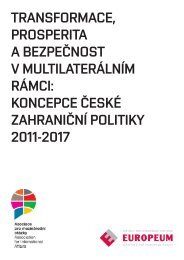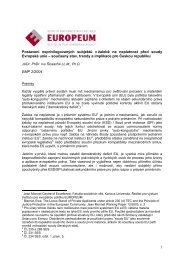eu constitutionalisation - EUROPEUM Institute for European Policy
eu constitutionalisation - EUROPEUM Institute for European Policy
eu constitutionalisation - EUROPEUM Institute for European Policy
Create successful ePaper yourself
Turn your PDF publications into a flip-book with our unique Google optimized e-Paper software.
Chapter 3: The 2004 IGC: Bargaining or Learning?g References to implications of divisions of Germany: Czech Republic andPoland wanted these references to be deleted, as they argued no referenceswere made to consequences of division of Europe in Cold War.g Stability and Growth Pact: Netherlands wanted fresh commitment tothis pact.Overall, the key issues related to the nature of decision-making in theUnion, the voice and representation of the member states, and memberstate control over sensitive issues. The Irish presidency presided over crucialstages of the bargaining process. In the next section an overview is providedof how the Irish presidency managed the above issues, be<strong>for</strong>e analysingthe theoretical explanations <strong>for</strong> the bargaining process.The Irish Presidency: Chronology of EventsFollowing the failure of the December Summit, the Irish presidency tookover responsibility <strong>for</strong> the IGC. The Italian presidency made a break-thoughon security and defence that was not substantially re-opened during theIrish presidency. In the conclusions of the December summit, the ppresidencywas mandated to ‘listen, assess and report’ back to the <strong>European</strong>Council in March. The mandate meant that the ppresidency’s managementof the IGC was in two phases. Phase one which ran from January to the endof March consisted of a series of very intensive bilateral meetings at politicaland official level with all member states. The ppresidency wanted to ensurethat all member states felt that their concerns were listened to and that theDublin team were in a position to make a judgement on where solutionsmight lie on the central issues. Working at both official and political levelin a process of ‘engaged listening’ atmosphere improved considerably earlyMarch 2004. Although none of the member states had actually given uptheir negotiating positions, all member states were positive about reachinga final agreement during the Irish presidency. The Madrid bombings andthe change of government in Spain altered the political context withinwhich an IGC was conducted. The <strong>European</strong> Council in March gave thego-ahead <strong>for</strong> the completion of the negotiations in June.The second phase of the presidency consisted of a pre-IGC bi-lateral phase inApril and the IGC itself was re-convened in May. This consisted of a meeting atofficial level on 4 May (Focal Points), three ministerial meetings (17-18 May, 24May and 14 June) and the <strong>European</strong> Council (17-18 June). The <strong>for</strong>mal meetingswere augmented by continuous bi-laterals at official and political level with allmember states. The presidency had to manage the dossier so that there werea sufficient number of meetings to get the work done but not so many thattoo many issues would be re-visited. The paper prepared <strong>for</strong> the focal pointmeeting at official level on 4 May had 50 annexes, which indicated how manyoutstanding issues remained on the table. The paper did not include any proposalsrelating to QMV, the issue that remained the most politically charged inthe negotiations. The presidency objective was to get agreement on the 50 or soissues so that only the most contentious issues would remain on the table <strong>for</strong>the <strong>European</strong> Council. The Taoiseach, Bertie Ahern, insisted that as much aspossible should be agreed going into the June Council so that political energycould be used to get agreement on the most contentious issues.Following the focal point meeting, the presidency adopted its end-gamestrategy <strong>for</strong> the remainder of the IGC by preparing two documents <strong>for</strong>the Foreign Ministers meeting on 17-18 May. Although the presidencymaintained the official position that ‘nothing is agreed until everything isagreed’, it presented two papers to the ministerial meeting:Closed Document: consisting of 43 annexes consisting of those issues onwhich the presidency maintained there was ‘broad consensus’ and onwhich there was no need <strong>for</strong> further ministerial discussion.Open Document: this document consisted of 15 annexes covering thoseissues on which further debate was necessary.Again the presidency did not offer new proposals on weighted voting butincluded ideas concerning the composition of the Commission. Followingthe May ministerial meeting, the presidency produced a further paper(CIG 79/04) providing a revised set of draft texts so that those issues thatwere broadly agreed so that they would not be re-opened at the <strong>European</strong>Council. By this stage of the negotiations, the closed document, consistingof 49 annexes, is getting progressively thicker. The ministerial meeting on14 June was designed to get agreement on most outstanding issues priorto the <strong>European</strong> Council. The ministerial meeting document dealt with 13different issues aimed at delivering a ‘fair overall balance between differentdelegations’ views’.⁴¹ Based on the accumulated agreement from the earlier41) CIG 80/04Chapter 3: The 2004 IGC: Bargaining or Learning?90 91








